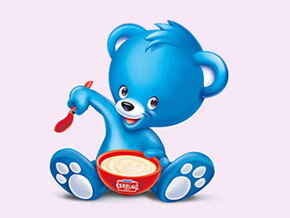
Q1. What is the ideal food for your child's early weaning period?
• After passing the age of six months, breast milk alone is not considered enough to supply the necessary nutrients required for your baby, so you must use solid foods to satisfy his nutritional needs, and iron in particular.
• Waiting until the age of six months to introduce solid foods into the nutritional system of your child will help to reduce the risk of adverse reactions to foods, as well as relieve allergies, especially if your family has a history of allergies.
Your baby will be ready to eat solid foods if he:
• Can keep his head steady and sit well when assisted
• Is able to move the food into his mouth and swallow it
• His weight is ideal, i.e. double what it was at birth
• Shows curiosity and interest in the food you eat
• Begins to look at your food and may even try to move it from the plate into his mouth
At all stages of human life, and not only during childhood, cereal meals are an important part of a healthy diet. During weaning, these meals are especially important and they represent an ideal food for the child during this stage, as they provide him with the food components he needs in a small meal to suit his small stomach. In the later stages of childhood, cereal meals encourage older children to experience new food tastes and textures.
Iron-fortified rice infant cereals and wheat infant cereal meals are the first foods doctors recommend at the start of the weaning period. Give it to your child with a soft rubber spoon once every day, then continue with his dose of milk. This way, your child will not be too hungry and frustrated from trying the new food, or satisfied to a point where he does not care about food. However, he needs only small amounts at this age, so it is better to give him small meals of 3 to 6 tablespoons, once or twice a day.
Q2. What is the best way to introduce new food tastes and textures to your child?
From the age of 6 months to the first year:
After your child accepts the rice infant cereal and wheat infant cereal meals, you need to introduce a new meal, one at a time, and give the same meal for a period of at least 3 days before introducing him to another new one. This is very important so that you know if your child bears this type of food or if he would be allergic to it.
It's time to try new tastes. Your baby can now swallow thicker foods than milk, such as various types of mashed meals or those prepared in a blender, and the different kinds of infant cereals made especially for children. Your baby's digestive system has also developed further as his stomach is growing and has become less sensitive than before. It is important for your baby's first food to be easy to swallow and digest in the first phase. So, it is advised to feed him food that is soft with a smooth texture, such as the one that contains one type of mashed fruit or vegetable and infant cereal meals.
Do not feel worried if your child does not like the food he tastes for the first time. Keep on trying, as the child may feel surprised with new things, but soon gets used to them and starts to like them the second, third or even fourth time.
Taking care to provide new foods will give you the chance to notice allergy symptoms such as diarrhea, abdominal pain and rash. Try adding a new type of food every few days, starting with fruits and vegetables that are easy for children to digest. Foods that can be given include: boiled and mashed apples, bananas, carrots, peaches, pears, and sweet potatoes. Try to obtain a homogeneous mixture by adding warm water. It is better to avoid cucumbers, onions, cabbage, broccoli, cauliflower and the like until your baby is one year old because they are difficult to digest. It is also advised not to use spinach and beets because they contain a high concentration of nitrates.
After that, you can provide a selection of meat, except egg whites.
Note: Do not add salt, sugar or honey* or any other sweeteners to your baby's food and do not introduce cow milk to his nutritional system until he reaches his first year. After one year of age, it is time for young children to get what they need through a variety of foods. This is a transitional period, where children learn how to eat and accept new foods with a new taste and texture. Then you can provide your baby with CERELAC® Infant Cereal. It is the perfect choice for this stage of weaning as it provides a pleasant and appropriate texture for the growing chewing abilities of your one year-old child with a variety of fruit and cereal pieces.
Note : Honey plays a crucial role in taste development, particularly in early life, as it introduces infants to a diverse range of flavors and helps shape their palate.
However, honey can contain the bacteria that may cause infant botulism. Consequently, honey should not be introduced before 12 months of age unless the spores of Clostridium botulinum have been inactivated by adequate high-pressure and high-temperature treatment, as used by industry.
Whenever honey is used in our products, it undergoes an externally validated treatment that ensures our products are safe to consume.




















